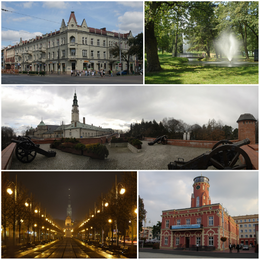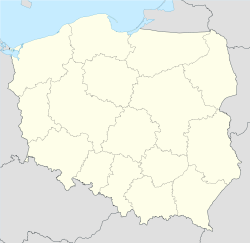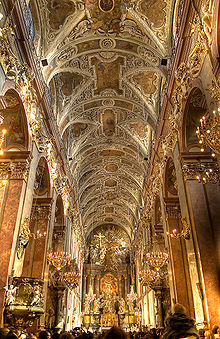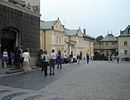- Częstochowa
-
Not to be confused with Cestohowa, Texas.
Częstochowa Częstochowa tourist's attractions 
Flag
Coat of armsMotto: Częstochowa to dobre miasto
(Częstochowa is a good city)Coordinates: 50°48′N 19°7′E / 50.8°N 19.117°E Country  Poland
PolandVoivodeship Silesian County city county Established 11th century Town rights 1356 Government – Mayor Krzysztof Matyjaszczyk Area – City 160 km2 (61.8 sq mi) Population (2009) – City 240,027 – Density 1,500.2/km2 (3,885.4/sq mi) – Metro 400,000 Time zone CET (UTC+1) – Summer (DST) CEST (UTC+2) Postal code 42-200 to 42-229, 42-263, 42-271, 42-280, 42-294 Area code(s) +48 34 Car plates SC Website http://www.czestochowa.pl/ Częstochowa [t͡ʂɛ̃stɔˈxɔva] (
 listen) is a city in south Poland on the Warta River with 240,027 inhabitants (June 2009). It has been situated in the Silesian Voivodeship (administrative division) since 1999, and was previously the capital of Częstochowa Voivodeship (1975–1998). However, Częstochowa is historically part of Lesser Poland, not of Silesia, and before 1795 (see: Partitions of Poland), it belonged to the Kraków Voivodeship.
listen) is a city in south Poland on the Warta River with 240,027 inhabitants (June 2009). It has been situated in the Silesian Voivodeship (administrative division) since 1999, and was previously the capital of Częstochowa Voivodeship (1975–1998). However, Częstochowa is historically part of Lesser Poland, not of Silesia, and before 1795 (see: Partitions of Poland), it belonged to the Kraków Voivodeship.The town is known for the famous Pauline monastery of Jasna Góra, which is the home of the Black Madonna painting (Polish: Jasnogórski Cudowny obraz Najświętszej Maryi Panny Niepokalanie Poczętej), a shrine to the Virgin Mary. Every year, millions of pilgrims from all over the world come to Częstochowa to see it. There is also a Lusatian culture excavation site and museum in the city and ruins of a medieval castle in Olsztyn, approximately 25 kilometres (ca. 16 mi) from the city centre.[1]
Contents
City name
The name of Częstochowa means Częstoch's place and comes from a personal name of Częstoch mentioned in the medieval documents also as Częstobor and Częstomir. Variations of the name include Czanstochowa used in 1220, and Częstochow used in 1382 and 1558. A part of today's city called Częstochówka was a separate municipality mentioned in 14th century as the Old Częstochowa (Antiquo Czanstochowa, 1382) and Częstochówka in 1470-80.
The city was also known in German as Tschenstochau and in Russian as Ченстохов (Chenstokhov).
History
13th century-16th century
The village of Częstochowa was first mentioned in historical documents from 1220. In 1382 the Paulist monastery of Jasna Góra was founded by Władysław Opolczyk (Ladislav of Opole) - the Polish Piast prince of Upper Silesia. Two years later the monastery received its famous Black Madonna icon of the Virgin Mary and in subsequent years became a centre of pilgrimage, contributing to the growth of the adjacent town. Before 1377 Częstochowa received a town charter, which was later changed to the Magdeburg Law in 1502.
17th-18th centuries
In the 17th century the local monastery was turned into a fortress, which was one of the pockets of Polish resistance against the Swedish armies during The Deluge in 1655. The Jewish community in Częstochowa came into existence by about 1700. After the second Partition of Poland it was annexed by Prussia.
After 1760[when?], Jacob Frank, the leader of a Jewish sect mixing Kabbalah, Catholicism and Islam, was imprisoned for heresy in the monastery by the church. His followers established near him, later establishing a cult of his daughter Eve Frank. In August of 1772, Frank was released by the Russian general Bibikov, who had taken occupation of the city.
19th century
During the Napoleonic Wars, in 1807 Częstochowa became part of the Duchy of Warsaw and in 1815 the Kingdom of Poland. This started a period of fast growth of the city. In 1819 renowned[peacock term] military architect Jan Bernhard planned and started the construction of Aleja Najświętszej Panny Marii - the Holiest Virgin Mary Avenue, which is currently the main arterial road of the modern city. The two existing towns of Częstochowa and Częstochówka (the latter received the city rights in 1717 as Nowa Częstochowa) were finally merged in 1826.
In 1846 the Warsaw-Vienna Railway line was opened, linking the city with the rest of Europe. After 1870 iron ore started to be developed in the area, which gave a boost to the local industry. Among the most notable investments of the epoch was the Huta Częstochowa steel mill built by Bernard Hantke, as well as several weaveries and paper factories. Up to the Second World War, like many other cities in Europe, Częstochowa had a significant Jewish population: according to Russian census of 1897, out of the total population of 45,130, Jews constituted 12,000 (so around 26% percent).[2]
20th century
During World War I the town came under German occupation, and in 1918 it became a part of the newly-reborn Republic of Poland. The new state acquired large deposits of good iron ore in Silesia and the mines in Częstochowa became inefficient and soon after were closed. This brought the period of prosperity to an end. At the same time a bishopric was relocated to the city in 1925.
After the Polish Defensive War of 1939, the town was occupied by Nazi Germany, renamed to Tschenstochau, and incorporated into the General Government. The Nazis marched into Częstochowa on Sunday, September 3, 1939, two days after they invaded Poland. The next day, which became known as Bloody Monday,[3] approximately 150 Jews were shot dead by the Germans.[4] On April 9, 1941, a ghetto for Jews was created.[5] During World War II approximately 45,000 of Częstochowa's Jews, almost the entire Jewish community living there, were killed by the Germans. Life in Nazi-occupied Częstochowa is depicted in the Pulitzer Prize-winning graphic novel Maus, by Art Spiegelman, the son of a Jewish Częstochowa resident. Before the Holocaust, Częstochowa was considered a great Jewish center in Poland. By the end of WWII, the town was essentially Judenrein.
The city was liberated from the Germans by the Red Army on January 16, 1945. Due to the communist idea of fast industrialisation, the inefficient steel mill was significantly expanded and named after Bolesław Bierut. This, combined with the growing tourist movement, led to yet another period of fast city growth, concluded in 1975 with the creation of a separate Częstochowa Voivodeship.
In modern times, Pope John Paul II, a native son of Poland, prayed before the Madonna during his historic visit in 1979, several months after his election to the Chair of Peter. The Pope made another visit to Our Lady of Częstochowa in 1983 and again in 1991.[6]
Tourism
Currently the city is one of the main tourist attractions of the area and is sometimes called the little Nuremberg because of the number of souvenir shops and historical monuments.[citation needed] It attracts millions (4.5 mln - 2005) of tourists and pilgrims every year.
The Black Madonna of Częstochowa, housed at the Jasna Góra Monastery, is a particularly popular attraction.[6]
Transport
National Road 1 in Częstochowa
Main road connections from Częstochowa include a connection with Warsaw (to the north-east) and Katowice (to the south) via the European route E75 (National Road Wieluń, Opole and Piotrków Trybunalski.
Furthermore, Częstochowa is a major railroad hub, located at the intersection of two important lines - west-east (from Lubliniec to Kielce) and north-south (from Warsaw to Katowice). Also, an additional northbound line stems from Częstochowa, which goes to Chorzew Siemkowice, where it joins the Polish Coal Trunk-Line. There are six railway stations in the city, the biggest ones being Częstochowa Osobowa and Częstochowa Stradom.
Education
Some of the educational institutions in Częstochowa include:
- Politechnika Częstochowska [7]
- Akademia Jana Długosza (previously Wyższa Szkoła Pedagogiczna) [8]
- Polonia University (previously Wyższa Szkoła Języków Obcych i Ekonomii) [9]
- Wyższa Szkoła Hotelarstwa i Turystyki
- Wyższa Szkoła Lingwistyczna [10]
- Wyższa Szkoła Zarządzania
Sports
Sports highlights include:
- CKM Włókniarz Częstochowa – speedway team from Częstochowa, 3rd place in season 2005, 2nd place in season 2006 first place in season 2003, 3rd place in 2009
- Klub Sportowy Beniaminek Częstochowa (Called BKS) – football team from Częstochowa playing in Second Polish Football League.
- Domex Tytan AZS Częstochowa – men's volleyball team playing in Polish Volleyball League (Polska Liga Siatkówki, PLS), 2nd place in season 2007/2008.
- Tytan Częstochowa – Częstochowa's basketball team, plays in first league of Dominet Basket Liga (Polska Liga Koszykówki, PLK)
- Rugby Club Częstochowa – Częstochowa's rugby team, plays in Polish 3rd League rugby XV and in 7's League.
- Rakow Czestochowa - Czestochowa's football team, plays in the II League of Poland.
Politics
Częstochowa constituency
The Members of the lower house of Parliament (Sejm) elected by the Częstochowa constituency include:
- Szymon Giżyński (Law and Justice)
- Lucjan Karasiewicz (Law and Justice)
- Jadwiga Wiśniewska (Law and Justice)
- Halina Rozpondek (Citizens Platform)
- Izabela Leszczyna (Citizens Platform)
- Krzysztof Matyjaszczyk (Alliance of the Democratic Left)
- Grzegorz Sztolcman (Citizens Platform)
The Members of the higher house of Parliament (Senate) elected by the Częstochowa constituency include:
- Andrzej Szewiński (Citizens Platform)
- Czesław Ryszka (Law and Justice)
International relations
Gallery
-
Monument of Jozef Piłsudski
Twin towns – Sister cities
Częstochowa is twinned with:[11]
Notable people
- Jakub Błaszczykowski
- Janusz Sybis
- Abraham Bomba
See also
- Shrines to the Virgin Mary
- Jan Dlugosz University
Notes
- ^ "Częstochowa Official Website". © Urząd Miasta Częstochowy, Śląska 11/13, 42-217 Częstochowa. http://www.czestochowa.pl/languages-en?set_language=en. Retrieved 2008-10-22.
- ^ Joshua D. Zimmerman, Poles, Jews, and the politics of nationality, Univ of Wisconsin Press, 2004, ISBN 0299194647, Google Print, p.16
- ^ Częstochowa, Poland (pages 39-47)
- ^ [1][dead link]
- ^ Holocaust Survivors: Encyclopedia – "Częstochowa Ghetto"
- ^ a b Duricy, Michael P. "Black Madonnas: Our Lady of Częstochowa". © 2008 The Marian Library/International Marian Research Institute, Dayton, Ohio. http://campus.udayton.edu/mary//meditations/olczest.html. Retrieved 2008-10-22.
- ^ Politechnika Częstochowska
- ^ Akademia Jana Długosza (previously Wyższa Szkoła Pedagogiczna)
- ^ Akademia Polonijna – Polonia University (previously Wyższa Szkoła Języków Obcych i Ekonomii)
- ^ Wyższa Szkoła Lingwistyczna
- ^ a b c d e "Association of Towns awarded The Europe Prize". www.czestochowa.um.gov.pl. http://www.czestochowa.um.gov.pl/europeprize/altotting.htm. Retrieved 2009-10-10.
- ^ "Twinning with Palestine". © 1998-2008 The Britain - Palestine Twinning Network. http://www.twinningwithpalestine.net/groupsinternational.html. Retrieved 2008-11-29.
- ^ "::Bethlehem Municipality::". www.bethlehem-city.org. http://www.bethlehem-city.org/Twining.php. Retrieved 2009-10-10.
References
- Duricy, Michael P. "Black Madonnas: Our Lady of Częstochowa". © 2008 The Marian Library/International Marian Research Institute, Dayton, Ohio. http://campus.udayton.edu/mary//meditations/olczest.html. Retrieved 2008-10-22.
- "Jasna Góra". © 1998-2008 Copyright by Klasztor OO. Paulinów Jasna Góra - Częstochowa. http://www.jasnagora.pl/. Retrieved 2008-10-22.
- "Częstochowa Official Website". © Urząd Miasta Częstochowy, Śląska 11/13, 42-217 Częstochowa. http://www.czestochowa.pl/languages-en?set_language=en. Retrieved 2008-10-22.
General
- Official website
- Residents' portal
- Portal Częstochowa Online
- City forum
- Shockwave Map of the City
- The Black Madonna Monastery
- Jewish Częstochowa
- Gidonim Jewish cemetery information for Częstochowa
- Częstochowa-Radomsko Area Research Group (CRARG) – for Jewish genealogy
- Czestochowa-Spiritual heart of Poland – ILovePoland.co.uk
History
- Częstochowa Yizkor Book – remembering Częstochowa Jews murdered by Nazis
- 8 Częstochowa Yizkor Books at NYPL
Principal cities of Poland 
Counties of Silesian Voivodeship City counties Katowice (capital) • Bielsko-Biała • Bytom • Chorzów • Częstochowa • Dąbrowa Górnicza • Gliwice • Jastrzębie-Zdrój • Jaworzno • Mysłowice • Piekary Śląskie • Ruda Śląska • Rybnik • Siemianowice Śląskie • Sosnowiec • Świętochłowice • Tychy • Zabrze • Żory
Land counties Urban-rural gminas 
Rural gminas Seat (not part of the county) CzęstochowaCategories:- Populated places established in the 11th century
- Częstochowa
- Black Madonna of Częstochowa
- City counties of Poland
- Cities and towns in Silesian Voivodeship
- Holy cities
Wikimedia Foundation. 2010.





























